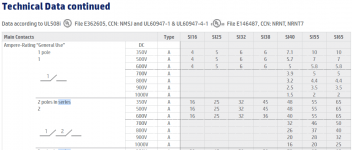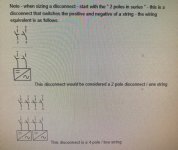wwhitney
Senior Member
- Location
- Berkeley, CA
- Occupation
- Retired
Not every PV system uses inverters. Given the requirements for a PV system disconnect as listed in 690.13, a DC PV system disconnect only exists in PV installations with DC loads and no inverters, as jaggedben commented. That's why in the list in the definition of PV DC Source Circuit, the item "DC PV system disconnect" comes after "electronic power converters," it is to cover the case there are no electronic power converters at all.How is it not? If the disconnect were on the other side of the inverter, it is a PV system disconnect, not a DC PV system disconnect. It has to be on the DC side of the inverter to be a DC PV system disconnect, so it is before the inverter.
The DC disconnect in a system with an inverter doesn't obviate 690.12 by avoiding the existence of controlled conductors; it may satisfy 690.12 by being the rapid shutdown initiation device for the controlled conductors on the grid side of the DC disconnect.
Cheers, Wayne



